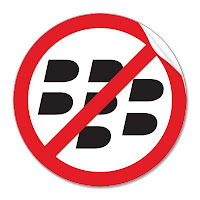Selasa, 25 Januari 2011
Selasa, 11 Januari 2011
Sekali Lagi Tentang Blackberry
Blackberry (diterjemahkan dari Brombeere, nama buah semacam strawberry) adalah sejenis smartphone yang khusus dipakai untuk menulis, mengirim, dan membaca email. Blackberry dibuat oleh Research in Motion, sebuah perusahaan di Kanada, sebagai salah satu solusi untuk komunikasi dan administrasi data pribadi. Istilah kerennya:Personal Information Manager.
Infrastruktur Blackberry meliputi sebuah arsitektur client-server, satu protokol proprietas (buatan dan milik RIM) antaraclient dan server, dan suatu kumpulan dari smartphone buatan RIM. Sistem Operasinya juga menunjang Java (J2ME) dengan antarmuka khusus.
Hubungan di dalam jaringan melewati GPRS/EDGE, UMTS, atau WLAN. Artinya: melalui jaringan internet yang sudah ada. Berlainan dengan PDA, pengguna Blackberry tidak perlu melakukan sinkronisasi data. Secara otomatis layanan akan dikirim oleh Blackberry Enterprise Server. Sistem Blackberry akan senantiasa diaktualisasi, selama ada hubungan aliasonline. Kiriman email akan meluncur secepat SMS, satu kali keliling dunia ditempuh dalam waktu seperdelapan detik! Data email akan dikerdilkan sehingga tidak ada yang besarnya melampaui 2 kByte’s. Data yang lebih besar dari itu akan diatur otomatis sehingga pengguna tidak akan menyadarinya. Misalnya data yang berekstensi pdf atau doc (office) dalam satuan Mbyte akan tetap terkirim dengan cepat kendati melalui GPRS.
Sistem Sandi Blackberry
Penyandian alias komponen pengaman Blackberry yang sulit ditembus itu adalah enkripsi AES (Advanced Encryption Standard) sebesar 256-bits. Transfer data antara pengguna dan server (di Inggris atau Kanada) selalu dienkripsi alias disandikan. Bahasa jelasnya: aman dan anti penyadapan!
Pembuatan kunci sandi berbasis random generator pada saat pertama aktifnya Blackberry. Kunci ini berlaku maksimal 30 hari, sampai ada pembaruan. Namun pengguna dapat membuat kunci sandi setiap saat lewat tombol paranoia. Pengguna dimungkinkan pula untuk membuat password yang sangat aman, yaitu sampai dengan 24 karakter. Password yang paling kompleks dan mustahil untuk di-crack itu seyogjanya disusun dengan kombinasi huruf case-sensitive (pembedaan huruf besar dan kecil), simbol, dan angka.
Pada mulanya dulu, awal tahun 2000-an, tujuan penggunaan Blackberry hanya untuk email. RIM mengembangkan sendiri semua standar program, hardware, dan sistem operasi Blackberry, sampai saat ini. Ciri khas lainnya adalah struktur sentral jaringan Blackberry. RIM mengembangkan lalu lintas email via Blackberry di seluruh dunia hanya lewat 2 sistem serversentral. Satu ada di Kanada yang melayani jaringan Blackberry untuk pengguna di Amerika Utara (Meksiko, AS, Kanada, sampai Alaska). Lokasi server sentral yang kedua ada di Inggris bagi lintas email negara-negara lainnya. Menurut RIM, server di Inggris itu tidak menyimpan data, melainkan meneruskannya ke server di Kanada. Sentral Blackberry yang sebenarnya.
Sebetulnya sistem email Blackberry yang tertutup rapat itulah salah satu alasan mengapa alat ini demikian populer. Terutama di kalangan pebisnis. Transaksi dagang dapat dilakukan bebas tanpa kemungkinan dibajak. Besar pajak bisa diakali tanpa khawatir dilihat oleh kantor pajak, misalnya. Atau kirim-mengirim berita-berita yang dianggap top secret oleh penggunanya. Fakta ini membuat Blackberry mengungguli para produsen smartphone pesaing seperti Nokia atau Apple. Pengguna Blackberry di dunia saat ini sudah tembus angka 40 juta!
Kontroversi
Layanan BlackBerry cukup banyak dipermasalahkan oleh para otoritas meski kasusnya mungkin berbeda-beda. Negara-negara yang mendesak RIM itu antara lain, India, Arab Saudi, Uni Emirat Arab, Pakistan dan Cina. Berbagai alasan disampaikan kepada RIM, yang cukup krusial adalah karena alasan ancaman bagi keamanan negara. Demikian pula India dan Libanon. Komisi Pemerintah Uni Eropa juga melarang penggunaan Blackberry bagi 32.000 pegawainya, dengan alasan keamanan. Hal yang sama juga dilakukan oleh pemerintah Jerman. Mengapa begitu?
Research in Motion (RIM) adalah perusahaan yang mengembangkan dan membuat Blackberry dengan caranya sendiri. Kendati alat ini mengirim dan menerima email melalui internet, namun disandikan demikian rupa supaya hanya bisa dibaca oleh pengguna tujuan. Menurut RIM, sistem enkripsi atau penyandian itu begitu canggih, sehinggasupercomputer pun butuh waktu miliaran tahun untuk menjebol kode sandinya.
Dengan kalimat lain, berita yang berseliweran keluar masuk dari dan ke Blackberry nyaris tidak bisa diketahui isinya. Apalagi dikontrol. Inilah alasan kuat melarang penggunaan Blackberry! Selain itu juga ada kecurigaan para kritikus Blackberry, jangan-jangan badan intelijen negara Inggris dan Kanada (sebagai lokasi server) secara diam-diam membaca data dan berita pengguna dari seluruh dunia! Kendati hal ini dibantah keras oleh RIM.
Menangggapi tekanan berbagai negara itu, RIM telah menyatakan siap untuk memblokir 3.000 situs porno bagi pengguna Blackberry di Kuwait. Arab Saudi telah minta agar RIM memblokir program untuk Berita Pendek dan / atauBreaking News. Di India RIM merencanakan untuk meletakkan server antara, sehingga pemerintah India dapat mengontrol lalu lintas data Blackberry.
Rencana Larangan di berbagai negara
Pemerintah India meminta RIM untuk bisa mengakses data serta melacak email yang dikirim atau diterima pengguna blackberry di India. Mereka khawatir layanan tersebut disalahgunakan oleh para militan dan menciptakan ketidakstabilan politik. Selama ini, kelompok gerilyawan berbasis Pakistan memang kerap berbagai layanan komunikasi yang sulit dipantau pemerintah India. Mereka menggunakan BlackBerry, telepon selular, serta percakapan lewat Google Talk dan Skype. Hingga kini pemerintah India belum sepakat dengan RIM.
Lain halnya dengan India, Pakistan meminta RIM umenutup akses ke situs jejaring sosial Facebook lewat layanan BlackBerry. Dewan Telekomunikasi Pakistanmengeluarkan permintaan itu setelah Pengadilan Tinggi Lahore melarang Facebook gara-gara ada kompetisi menggambar Nabi Muhammad yang disebarkan lewat Facebook
Ancaman penutupan BlackBerry dilancarkan pula oleh otoritas di Uni Emirat Arab. UEAmenuntut izin khusus mengakses data yang sudah terenkripsi di sistem BlackBerry. Seperti halnya India, UEA cemas BlackBerry dimanfaatkan untuk mengganggu keamanan negara, bahkan jadi alat mata-mata Israel.
Sedangkan di Indonesia, beberapa alasan unofficial yang disampaikan oleh menkominfo (dalam twitternya) mengenai rencana pemblokiran Blackberry RIM (sebagian servicesnya), antara lain :
- Data Pakar IT: ada 3 juta pelanggan RIM/BB di Indonesia. 2 jt resmi dan 1 jt black market.
- Dengan rata-rata menagih $ 7 USD/org/bulan. RIM menangguk pemasukan bersih Rp 189 Milyar/bln atau RP 2,268 Trilyun/thn. Uang rakyat Indonesia utk RIM
- RIM Tanpa bayar pajak sepeserpun kepada RI, tanpa bangun infrastruktur jaringan apapun di RI. Seluruh jaringan adalah milik 6 operator di Indonesia.
- Semua operator yg lain sudah menjalankan dan mematuhi UU dan peraturan RI, spt: bayar BHP frekuensi, pajak, rekrut tenaga kerja, CSR, membantu korban2 Merapi, korban Mentawai, korban Wasior, bencana2 lainnya dan blokir pornografi.
Dari apa yang disampaikan diatas, pasti akan menimbulkan kontroversi lagi dikalangan penggunanya. Perlu sikap bijak didalam mengambil keputusan dan juga yang menerima akibat dari keputusan tersebut. Pemerintah Indonesia tentunya tidak akan sembarangan untuk hal ini. Apapun keputusan yang dikeluarkan oleh pemerintah, mari kita ambil sisi positifnya. Mudah-mudahan para pakar IT Indonesia terdorong untuk menciptakan layanan yang sama seperti layanan Blackberry RIM, itu jika pemblokiran jadi dilaksanakan. Jika tidak, lanjutkan!
(dari berbagai sumber)
Langganan:
Komentar (Atom)
















